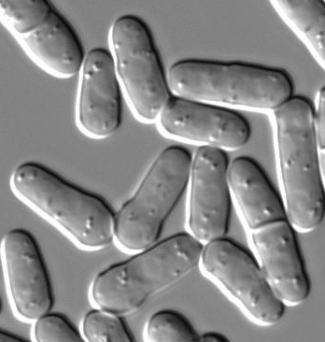One Protein, Three Functions

Even long after the "one gene, one enzyme" hypothesis, proposed in 1941 by Beadle and Tatum, was cornered by the discovery of gene splicing, the concept of "one protein, one function" stood firmly for many years as a fundamental truth of molecular biology. However, the discovery in the late ‘80s of proteins that could perform two entirely different functions was a breaking point in the classic perception of biology. Such proteins were named "moonlighting proteins" by Constance Jeffery in 1999, in reference to the meaning of the verb "to moonlight" (to have more than one job). This term has been widely accepted, especially since the discovery of many examples of these proteins in the past 15 years.
The existence of "moonlighting" proteins increases the variability of the coding potential of a genome. Another source of variability is gene fusion. In this process, two genes that are normally found apart in the genomes appear joined in certain species, thus producing a single protein with two functions. If the fusion is beneficial, the event remains in the genome of these species. The functions joined in a fused gene are often related (enzymes of the same metabolic pathway, etc.).
The Yeast Molecular Biology Group at the UAB reported in 2009 an interesting example of moonlighting protein in the yeast Saccharomyces cerevisiae. The Hal3 protein, which had been characterised by this group as a regulatory subunit of an enzyme (a phosphatase exclusive of fungi and important in the homeostasis of cations), was also part of an enzymatic complex with decarboxilase activity and necessary for the synthesis of an essential and universal molecule: Coenzyme A. The work was continued to explore the possible role of moonlighting proteins similar to Hal3 in other organisms. This led to the identification in a very different yeast, the fission yeast Schizosaccharomyces pombe, of a surprising gene: while in its first half it encoded a protein similar to Hal3, the second half clearly contained the enzyme thymidylate synthase (TS). TS activity is necessary for the synthesis of thymine, one of the pieces that make up the DNA. This enzyme represents an important target in cancer therapy.
The UAB group, directed by Dr. Joaquín Ariño, has led an international team which has recently clarified the role of the protein encoded by this S. pombe gene (named by the team as Sp hal3). The result of the study, published in the journal Molecular Microbiology, shows that Sp hal3 can regulate the S. pombe phosphatase, encode the decarboxylase activity that contributes to synthesize coenzyme A and, finally, exhibit thymidylate synthase function. Therefore Sp hal3 is a gene coding for a protein with three totally different functions, as a result of a gene fusion event that involved a moonlighting protein. What could be the benefit derived from the coordination of these three activities in a single protein? Although further study will be needed, the authors recall the fact that altering the homeostasis of cations, the insufficient synthesis of coenzyme A, as well as an unbalance in the levels of the different nucleotides (such the resulting from blockage of TS activity) have a common output: genomic instability and DNA breakage. Therefore, the assembly of these three functions in a single protein could effectively contribute to the maintenance of genomic integrity.
References
Molero, C.; Petrényi, K.; González, A.; Carmona, M.; Gelis, S.; Abrie, J.A.; Strauss, E.; Ramos, J.; Dombradi, V.; Hidalgo, E., and Ariño, J. The Schizosaccharomyces pombe fusion gene hal3 encodes three distinct activities. Molecular Microbiology 90(2): 367-382. 2013.


